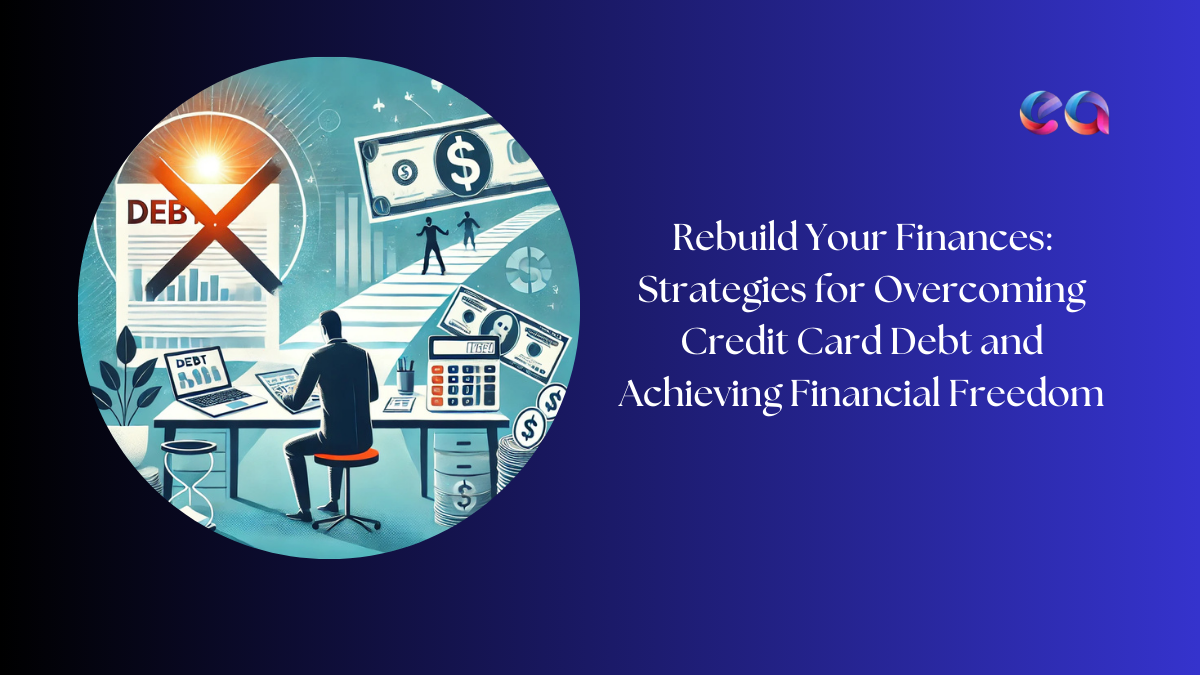
Credit card debt is a pressing issue for millions of individuals and households worldwide. It often begins innocuously—using a credit card for everyday purchases, emergencies, or special treats. However, high-interest rates and a lack of financial planning can lead to mounting balances that feel insurmountable. If you find yourself buried under credit card debt, know that you’re not alone, and there’s a pathway to financial freedom. This article will provide you with comprehensive strategies to rebuild your finances, eliminate debt, and achieve a more secure financial future.

Table of Contents
Understanding the Gravity of Credit Card Debt
Before diving into strategies for tackling credit card debt, it’s essential to understand why it is so harmful to your financial health. Credit card debt is often characterized by high-interest rates, sometimes exceeding 20% annually. This makes it one of the most expensive forms of borrowing. Without a clear repayment strategy, even minimum monthly payments may barely cover the interest, causing balances to grow over time.
The negative consequences of credit card debt include:
- High Interest Costs: You end up paying far more than the amount you initially borrowed.
- Damage to Credit Scores: A high credit utilization ratio and missed payments can lower your credit score, making future borrowing more expensive or inaccessible.
- Stress and Mental Health Issues: Financial stress caused by debt can lead to anxiety, depression, and strained relationships.
- Restricted Financial Goals: Credit card debt can prevent you from saving for retirement, buying a home, or investing in your future.
Step 1: Assess Your Financial Situation
The first step toward overcoming credit card debt is gaining a clear understanding of your financial situation. Here’s how to do it:
1. List Your Debts
Create a comprehensive list of all your credit card debts. Include:
- Total balances
- Interest rates
- Minimum monthly payments
- Payment due dates
2. Evaluate Your Income and Expenses
Track your income and expenses for at least one month to understand your spending patterns. Use budgeting apps or spreadsheets to categorize expenses and identify areas where you can cut back.
3. Calculate Your Debt-to-Income Ratio (DTI)
Your DTI is a critical indicator of financial health. It’s calculated as:
DTI=Total Monthly Debt PaymentsGross Monthly Income×100\text{DTI} = \frac{\text{Total Monthly Debt Payments}}{\text{Gross Monthly Income}} \times
100DTI=Gross Monthly IncomeTotal Monthly Debt Payments×100 A high DTI indicates financial strain and may signal the need for significant changes.
Step 2: Create a Realistic Budget
A budget is the cornerstone of any debt repayment strategy. Follow these steps to develop a sustainable financial plan:
1. Differentiate Between Needs and Wants
- Needs: Essential expenses like housing, utilities, groceries, and minimum debt payments.
- Wants: Non-essential expenses like dining out, streaming services, and luxury items.
Focus on fulfilling your needs while reducing discretionary spending.
2. Allocate Funds Strategically
Adopt the 50/30/20 Rule as a starting point:
- 50% for necessities
- 30% for discretionary spending
- 20% for debt repayment and savings
In cases of significant debt, you may need to dedicate more than 20% of your income toward repayment.
3. Track Your Progress
Regularly monitor your budget to ensure you’re adhering to it. Adjust as necessary based on changes in income or expenses.
Step 3: Choose a Debt Repayment Strategy
There are two primary strategies for paying off credit card debt: the debt snowball method and the debt avalanche method. Both have pros and cons, so choose the one that aligns with your financial goals and psychological preferences.
1. Debt Snowball Method
- How It Works: Focus on paying off the smallest debts first while making minimum payments on larger ones.
- Advantages: Provides quick wins that can boost motivation and confidence.
- Disadvantages: May result in higher interest costs over time.
2. Debt Avalanche Method
- How It Works: Prioritize paying off debts with the highest interest rates first.
- Advantages: Saves money on interest in the long term.
- Disadvantages: Progress may feel slower, which can be discouraging.
3. Consolidate or Refinance Your Debt
If you have multiple high-interest credit cards, consider consolidating them into a single loan with a lower interest rate or transferring balances to a card with a 0% introductory APR.
Step 4: Negotiate With Creditors
Don’t hesitate to reach out to your credit card companies to negotiate better terms. Many creditors are willing to work with customers who show a genuine intent to repay their debts.
1. Request a Lower Interest Rate
Explain your financial situation and ask for a reduced interest rate. A lower rate can significantly accelerate your repayment process.
2. Inquire About Hardship Programs
Some credit card companies offer hardship programs, which may include:
- Reduced minimum payments
- Waived fees
- Temporarily lower interest rates
3. Settle for Less Than You Owe
If your financial situation is dire, you may negotiate a lump-sum settlement for less than the total amount owed. Be aware that this can impact your credit score.
Step 5: Increase Your Income
While reducing expenses is critical, increasing your income can accelerate your journey to financial freedom.
1. Take on a Side Hustle
Explore part-time opportunities, freelancing, or gig work that aligns with your skills and schedule.
2. Sell Unnecessary Items
Declutter your home and sell items you no longer need. Platforms like eBay, Facebook Marketplace, and Craigslist can help you generate extra cash.
3. Seek a Raise or Promotion
If you’ve been performing well at your job, consider negotiating for a raise or applying for internal promotions.
Step 6: Build an Emergency Fund
An emergency fund is crucial for breaking the cycle of debt. Without one, unexpected expenses can force you to rely on credit cards again.
1. Start Small
Aim to save at least $1,000 initially, then work toward a goal of three to six months’ worth of living expenses.
2. Automate Savings
Set up automatic transfers to a dedicated savings account to ensure consistent progress.
3. Use Windfalls Wisely
Direct bonuses, tax refunds, or monetary gifts toward your emergency fund or debt repayment.
Step 7: Develop Healthy Financial Habits
Achieving financial freedom requires adopting habits that prevent future debt accumulation.
1. Avoid Impulse Spending
Implement a 24-hour rule for non-essential purchases to curb impulsive buying.
2. Use Credit Responsibly
- Pay off balances in full each month to avoid interest charges.
- Limit your credit card usage to essential purchases.
3. Regularly Review Your Finances
Set aside time each month to review your budget, expenses, and financial goals.
Step 8: Seek Professional Help if Needed
If you’re struggling to manage your debt independently, consider seeking assistance from professionals:
1. Credit Counseling
Nonprofit credit counseling agencies can help you create a debt management plan and negotiate with creditors.
2. Debt Settlement Companies
While these companies can negotiate settlements, be cautious of high fees and potential scams.
P. Financial Advisors
A certified financial planner can provide personalized guidance tailored to your long-term goals.
Step 9: Celebrate Milestones
Overcoming credit card debt is a significant achievement. Celebrate milestones along the way to stay motivated. Treat yourself in small, budget-friendly ways as you reach major repayment goals.
Conclusion:
Rebuilding your finances and achieving financial freedom is a journey that requires dedication, discipline, and perseverance. By understanding your debt, creating a realistic budget, and implementing effective repayment strategies, you can regain control of your financial future. Remember, each step forward brings you closer to a life free from the burden of credit card debt.
Take action today, and empower yourself to live a life of financial stability and security.









